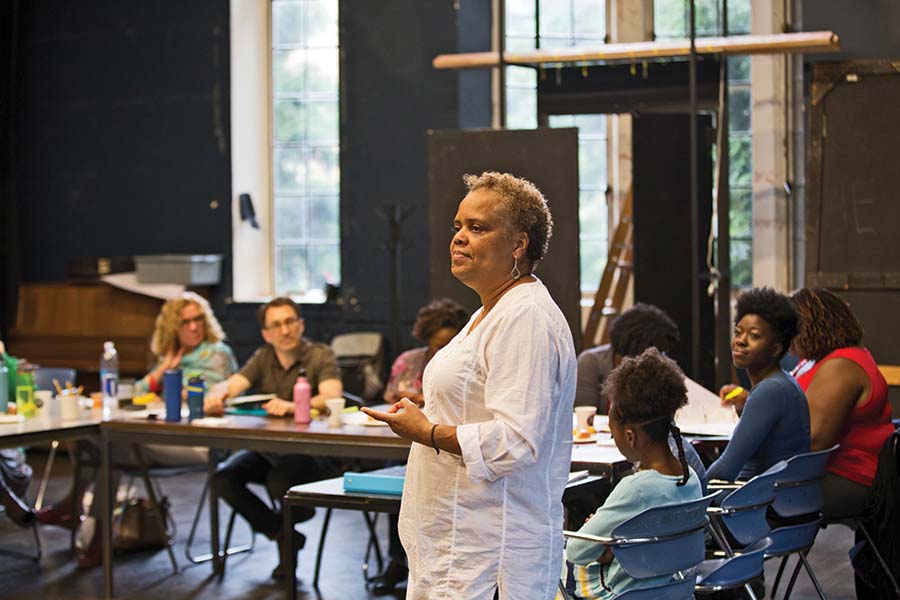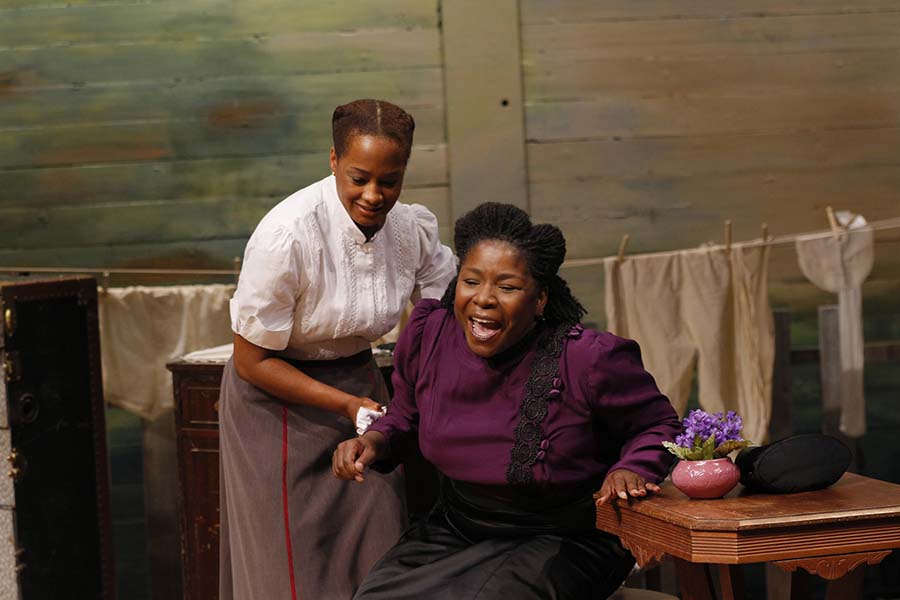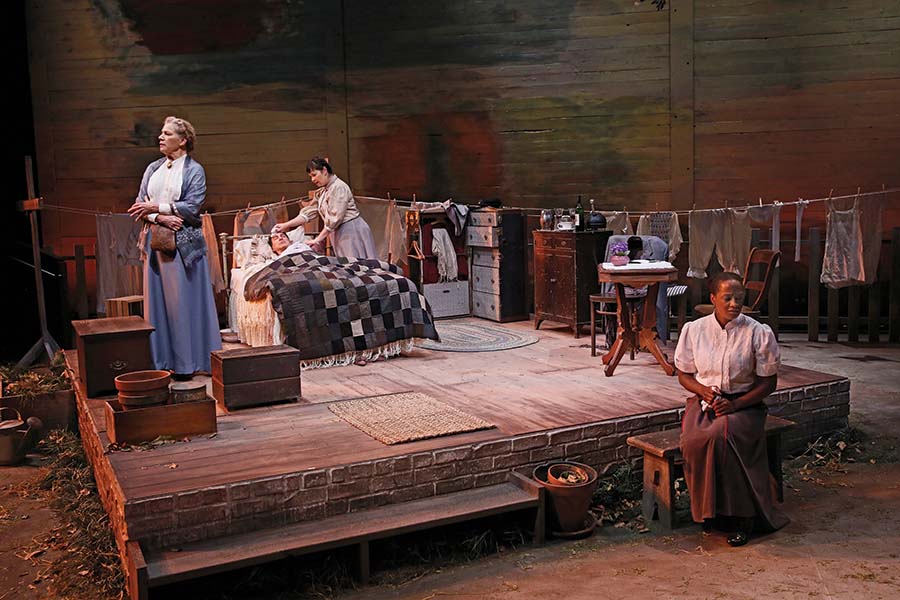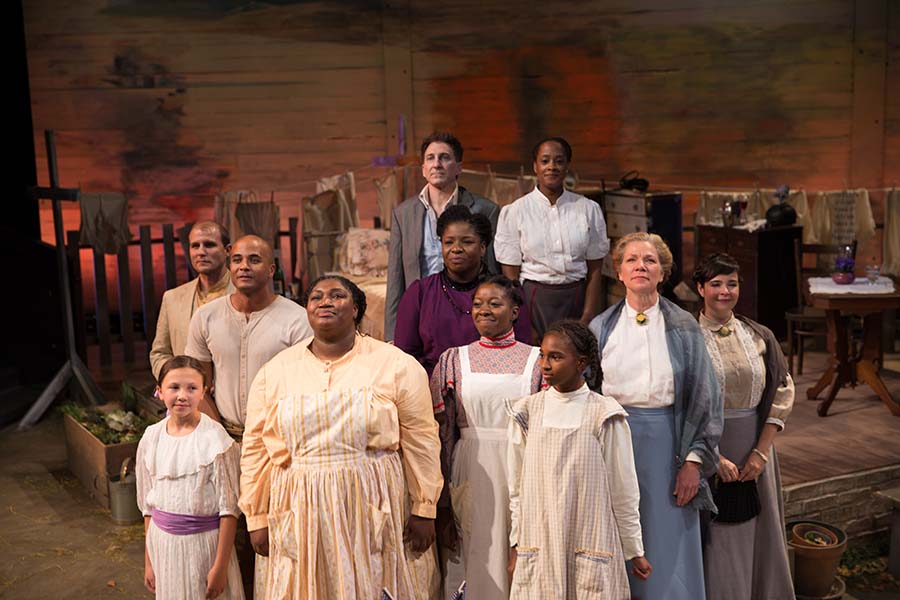How do you reintroduce and champion a provocative play that made a considerable splash several decades ago but has nearly fallen off the theatrical radar since then? A play you loved and once directed, and long to get another crack at?
Ask Valerie Curtis-Newton. The in-demand Seattle director and University of Washington drama professor recently realized a long-held wish to shed a brighter spotlight on the 1962 Alice Childress drama Wedding Band: A Love/Hate Story in Black and White. The play is an unsparing, heart-rending tale about the ramifications of a decade-long romance between a black seamstress and a white baker, set in Charleston, S.C., in 1918. Curtis-Newton mounted a September run of Wedding Band at UW’s Floyd and Delores Jones Playhouse, as part of a 2016 Intiman Theatre festival season she co-curated with that Seattle theatre’s producing artistic director, Andrew Russell. The season, not incidentally, was devoted entirely to the art of black female playwrights.
Though it has had an ongoing life on college campuses, there have been few professional productions of Wedding Band since the 1970s. (Antaeus Theatre Company in the Los Angeles area mounted a recent revival of note, in 2014.) But Curtis-Newton has treasured the play since first reading it as a UW graduate student in the 1990s, in Margaret B. Wilkerson’s important anthology 9 Plays by Black Women. Wedding Band’s multilayered story revolves around an interracial couple, Julia and Herman, who have loved each other devotedly but have also endured harsh, sometimes life-threatening disapproval from whites and scorn from blacks. When Julia moves out of self-imposed rural isolation into a Charleston enclave of black women and children, she and Herman must confront the impossibility of ever retreating into a private oasis amid a sea of Jim Crow segregation barely two generations removed from slavery. As Herman falls ill, Julia gradually reaches out to forge affirming bonds of solidarity with her neighbors.
The fearless authorial voice of Childress, who explored the interpersonal and social consequences of gender, class, and racial division with rare candor for her time, spoke directly and potently to Curtis-Newton. As rehearsals began last August, she recalled her initial attraction to Wedding Band and its author.
“Childress was looking compassionately but honestly at racism, and at silent, passive white privilege, and issues of class and prejudice,” the director noted. “I sort of fell in love with the idea that there was a writer bold enough to take on such hard topics while it was still illegal for black and white people to marry in some states. I also became fascinated with Childress’s own life story: She was an activist writer who lived in such an interesting period, and used her art to comment on it.”
Curtis-Newton first staged Wedding Band in a student production at the University of Washington. That made her an advocate for Childress, whose dozen plays, by the time of her death in 1994, had mostly slipped into obscurity. Years afterward, having successfully mounted two other Childress works—Wine in the Wilderness at Seattle’s ACT Theatre, and the better-known Trouble in Mind for the Intiman and for the Guthrie Theater in Minneapolis—Curtis-Newton was still itching to conceive a more mature, in-depth rendering of Wedding Band with seasoned actors.
“When I was younger, the play for me was all about the romance, and Julia and Herman,” she explained. “Now that I’m older I’m equally interested in the world in which the play takes place, the sense of community, and the way characters are struggling for economic power while just a breath away from destitution. They’re brave, in the ways that ordinary people can be brave.”
The Intiman’s Russell was also enthusiastic about presenting a play he calls “beautiful, insightful, so full of life.” He added that the theatre “originally thought about having an all-Childress season. But we decided we didn’t want to make it necessary for one play or one playwright to be asked to carry the whole black female perspective.”
So to round out the five-month festival, Russell and company also programmed Lydia Diamond’s satirical study of the black middle class, Stick Fly; readings of new works; and a community-based, collaborative piece about abuses of the criminal justice system, steered by Black Lives Matter cofounder Patrisse Cullors and coproducer C. Davida Ingram.
Also on the schedule, and drawing a sellout crowd, was the Black Woman Wisdom Summit, coproduced by the Hansberry Project, a nonprofit black theatre advocacy organization. In a private session and a rousing public conversation, 11 writers (among them Diamond, Regina Taylor, and Dominique Morisseau) talked candidly about, as Curtis-Newton framed it, “what it feels like to be black, female, and a playwright in these times.”

In five years at the Intiman’s helm (following the theatre’s near-death experience and rebirth), Russell has sharpened the company’s mission to presenting “theatre that is relevant to our time and as diverse as the community in which we live.” So why program a play that was written half a century ago and is set against a historical backdrop of World War I? The fact is that, despite its age, Wedding Band retains a timely ring.
The play hooks readily into a heightened national and local awareness of personal and institutionalized racism, spurred on by the Black Lives Matter movement and protests in numerous U.S. cities over police killings of unarmed young black men. (Intiman and several other Seattle arts institutions are participating in racial equity workshops organized by the City of Seattle.) The play also taps into the themes of a presidential campaign that highlighted persistent concerns about gender, racial, and economic inequities.
As she prepared for Wedding Band rehearsals over the summer, Curtis-Newton suggested it was time to ask a pertinent question: “Can we all stay in the room for these conversations, instead of screaming and walking away from each other? Characters in Wedding Band who are very different from each other do manage to stay in the room and work things through.”
It’s a mandate handed down from the show’s author, Curtis-Newton believes. “Alice was big on truth-telling and on staying in the room for the hard conversations,” observed Curtis-Newton. “My instinct as an artist is also to take the heat for strong choices, rather than be comfortable with weak ones.”
Born Alice Herndon in Charleston in about 1916 (accounts differ), the great-granddaughter of a slave, Childress was raised in Harlem. As a bright, ambitious teenager, she was drawn to theatre, and dropped out of high school to follow her stage dreams. She soon joined the American Negro Theatre, a seminal black troupe founded by Frederick O’Neal that also launched the careers of actors Sidney Poitier, Harry Belafonte, and Ruby Dee.
In nearly a dozen years with ANT, Childress became a jill-of-all-theatre-trades: performer, stage director, administrator, costume designer. She helped organize a union for Off-Broadway actors and earned a Tony nod for her performance in ANT’s 1944 hit Broadway run of the Philip Yordan play Anna Lucasta.
In 1949, eager to create more quality roles for African-American women, Childress co-starred in the first of her own plays to be produced, Florence, about two women, one white and one black, waiting for a train in a segregated station. The one-act focused on the fraught social, gender, and class dynamics that would ripple through most Childress plays, and later her popular young-adult novels.
The most-produced Childress work today is her 1955 breakthrough, Trouble in Mind, a scathing, seriocomic depiction of an interracial stage company rehearsing a liberal playwright’s anti-lynching drama, which nonetheless features derogatory racial stereotypes.
Wedding Band had a different tone and trajectory. Written in 1962 and debuted in 1966 at the University of Michigan, the play languished for five more years before Joseph Papp presented its Off-Broadway premiere at the New York Shakespeare Festival, with a fiercely compelling Ruby Dee as Julia. Papp codirected the production with Childress, and appreciated the raw vitality and edgy candor of the work. He praised the dialogue as “so authentic and rich, it’s like the loam in the earth. By itself, that is literature to me.”
Critic Clive Barnes overlooked those qualities in his 1972 review, tagging Wedding Band as “sentimental” and “rather old-fashioned in its attempt at Ibsenite realism.” But fellow New York Times critic John J. O’Connor reassessed the play as “a marvelous, exquisitely detailed period portrait, a complex blend of searing realism and poetic lyricism.”
There were a flurry of productions in Atlanta, Boston, Philadelphia, and other cities. And in 1974, during a brief commercial television flirtation with serious live drama, the New York Shakespeare Festival version was aired on “ABC Theater.” It sparked controversy when, despite a 1967 Supreme Court ruling (Loving v. Virginia) that had struck down all anti-miscegenation laws, some Southern ABC affiliates feared white backlash and refused to broadcast it.

With all of this history in mind, the initial blocking of the Intiman production began in a sweltering rehearsal hall on one of those infrequent Seattle days when the temperature tops 90 degrees.
In a climate as sultry as Charleston’s in the summer, Julia and Herman (Dedra Woods and Chris Ensweiler) began to tentatively find their way into their demanding roles. A proud, attractive seamstress in her mid-30s (and a precursor to the central character in Lynn Nottage’s widely produced 2003 play Intimate Apparel), Julia has experienced great joy and comfort as well as harsh indignities during her 10-year affair with Herman, who cannot legally marry her in South Carolina.
Julia has isolated herself in the countryside in an attempt to evade further abuse and rebukes. Calling her the “tent pole” of the play, Childress underscored how Julia’s move back to the African-American section of Charleston was a way of breaking out of her isolation, rejoining her people, and coping with mounting frustration over Herman’s failure to move with her to New York, where they could legally marry and start a new life together.
Performer Woods mused during a rehearsal break, “Herman has tried to put Julia in a box, and she’s tried to live in that box for him.” Added Curtis-Newton, “I want Dedra to explore the push-pull energy of Julia’s frustration. She’s drinking, and lonely, and isolated. She’s still drawn to Herman but also pulling away from him.”
During the preliminary blocking of scenes, with the director pausing frequently to quietly commune with the actors, Woods said about her process, “Right now I’m just trying to dive in and really trust that Val will lead me in the right direction. I want to maintain Julia’s strength, and not make her a victim of her circumstances.”
Meanwhile, Ensweiler—best known as a comedic actor—grappled with a range-stretching dramatic assignment. “There’s a lot of pressure working in an artistic genre that’s not comfortable for you,” he acknowledged.
Any actor might find Herman a hard climb, given the ways his love for Julia is strained by the financial dependence and venomous bigotry of his mother, and given his difficulty acknowledging the full scope and destructive force of Jim Crow racism. “Herman’s a courtly, gentle, and kind man,” reflected Ensweiler. “But in the play, that’s not enough. Herman desperately doesn’t want to inherit the racism of his parents, but he gets deluded. He believes that if they can just lock the door, he and Julia can be happy in their own little world.”
One climactic argument scene particularly challenged both actors. When Julia finally has it out with Herman, he is weak from the flu and feeling defensive, as she accuses whites of enslaving and exploiting her people for centuries. She hurls her anger at him: “My people…relatives, friends, and strangers…they worked and slaved for nothin’ for some of the biggest families down here.” Herman, who has toiled in his bakery for little reward, retorts, “What’s my privilege? I’m white, does it give me favors and friends?” When he tells her his family was “poor, no big name, no quality,” she responds, “Poor! My Gramma was a slave wash-woman bustin’ suds for free! Can’t get poorer than that!”
Working through the scene beat by beat, Curtis-Newton interjected, “She says ‘Your people did this,’ and he says, ‘I didn’t do it!’ It is like, whose oppression is bigger? Let’s see who wins that contest!” While accessing Julia’s anger, Woods empathized with Herman too: “It’s hard for someone to take ownership of a past that isn’t totally yours. But the dialogue starts there. You have it out, it’s rough, but you’re still alive.”
After trying the explosive exchange as written, Curtis-Newton asked the actors to try something else: What if they spoke their lines simultaneously, since neither was really hearing the other? The overlap made for an intensified but less rhetorical clash, and stayed in the show.
Other cast members grappled with different challenges. For example, Shaunyce Omar, as Julia’s kindly, maternal neighbor Lula, had to grovel before a racist white salesman (played by Martyn Krouse) as he threatened Lula’s belligerent soldier son Nelson (Jason Sanford). Yet Omar also had to indicate how her pleading was really just a survival tactic, not an abject display of self-subjugation.
And Anne Allgood struggled with the role of Herman’s hate-filled mother, a woman so terrified of scandal she refuses to call in a doctor after her son becomes seriously ill in Julia’s house. In a shattering, still-shocking scene, she shouts racist epithets at Julia, calling her a “dirty nigger” and a “black bitch,” concluding, “White reigns supreme!”
“I dreaded playing this role,” Allgood confessed. “I stood in judgment of the woman, and as a white person I felt guilty. I dreaded being in the rehearsal room and having to say those things.
“But,” she added, “Herman’s mother is humanized in the text, and Val has been a great help unpacking that. The woman had five stillborn babies, and feels like God is still ‘whipping’ her. Val also reminded us that for a widow in 1918, there was little financial survival without a man. She has nothing but this little bakery and Herman, and without him she’s sunk. That helped me realize her desperation, her rage at a son who for years has been spending money on a black mistress.”
Curtis-Newton alerted her actors that “on first reading the impulse is to condemn the white characters, even Herman. But we need to take a moment to look at how racism, capitalism, and sexism impact everybody. And once we get into that, and enter this world without preconceptions, all kinds of layers and nuances emerge.”
Childress herself noted, in an essay, “All whites aren’t bad or good, and the same goes for blacks—but this fact equalizes nothing. The whole racism mess is based upon the actions of white supremacists in deed and thought.”
The author didn’t let her black characters off the hook either: They toss off some derogatory remarks about “Chinamen,” Jews, and fellow African Americans. And Julia hurls racist insults right back at Herman’s mother. These moments required commitment from all the performers. As Woods said she told Allgood, “We have to be in this together. Every time we do that scene we have to go for it. In reality, if Julia lashed out at a white woman, she wouldn’t have survived. But in the world of the play, we get to see Julia assert herself in a way she didn’t know was possible.”

production of “Wedding Band.” (Photo by Chris Bennion)
While working closely with the cast, Curtis-Newton was also conferring often with Intiman artistic producer and scenic designer Jennifer Zeyl about the set. Noted Zeyl, “Wedding Band was written for a proscenium stage, but is going to be performed in a theatre with such a deep thrust, it’s almost in the round.”
The scripted stage directions call for the facades of three houses, all owned by the snooty black landlady Fanny and inhabited by her tenants Julia, Lula, and a young, struggling single mother, Mattie, and her daughter. One house is “cheery-looking,” and the other two are “weather-beaten and shabby, and each [has a] room visible to the audience.” Given the configuration of the intimate Playhouse Theatre, Zeyl’s set only exposed the bedroom of Julia’s home, which was centralized and raised. The rest of the action was exterior, spread over a yard shared by Fanny and her tenants.
“We thought of doing it on a turntable, but thank God we talked ourselves out of that,” Zeyl said with a laugh during load-in. “This is the way it needed to be. Julia’s room has no walls or ceilings, but it’s an intensely private space, and when people enter it’s an intrusion. The rest is shared space, a hub of activity—a ‘safe’ space for the black women to work and talk, until Herman comes in and opens a floodgate of whiteness.”
Zeyl left the back brick wall of the theatre exposed, with a portion painted in a color-washed, semi-abstract mural, in a vista inspired by the work of black painter Norman Lewis. A hanging branch of weeping Spanish moss evoked the South. And Zeyl was filling in atmospheric details right up to opening night: clothes on the line, a pile of chopped wood, and a working water pump in a yard “where Lula makes paper flowers to sell and laundry is done.” There were feminine touches that “match the poetry in the language—roses, lace, slippers, Fanny’s silver-plated tea service, Julia’s hope chest full of things she’s sewn.”
Meanwhile costume designer Mark Mitchell spent a lot of time “distressing” garments for poor characters who kept and patched clothes until they completely wore out. “I thought a lot of the women’s clothes were probably homemade, either by the people wearing them or the local dressmakers. Lula wore more old-style things, work clothes. Money was tight for people like her and Mattie, who screams at her daughter about losing a quarter.”
Mitchell clad Herman in “a workaday suit, rumpled from the heat with bakery flour on his pants. He dressed up a little, put his tie and jacket on, to visit Julia—that’s what you’d do if you were a ‘half-way gentleman,’ as he calls himself.”
At first Mitchell designed for Julia “a beautiful, pale-blue gingham period dress. But we decided it was wrong, because it made her look like a little doll, and she isn’t—she’s a strong woman. That’s why we put her in a skirt and shirtwaist, a crisp white blouse she probably made herself. And beautiful shoes, because Herman gave her money to buy them.”
For a final touch, Curtis-Newton and sound designer Matt Starritt decided to use clips of jazz violinist Regina Carter’s recording “Southern Comfort,” whose evocative folkloric impressions of the American South are lilting and haunting.

On opening night, Sept. 8, before a packed and attentive house, it all came together. Curtis-Newton ran the play without either of its two original intermissions, because “the experience of Julia doesn’t have a break. My instinct as a director was to not let up, to go with her.” By the end, as she comforts a dying Herman but gains a community, “We’re all crying with her, together.”
Those weren’t the only audience tears shed during this nuanced, cohesive performance of a play that, in its tenderness and tragedy, its articulation of racial division and healing, can be painful and cathartic. The audience collectively held its breath after the final moments before breaking into stunned, sustained applause.
For Woods, it was the end of a daunting process, but the start of a satisfying run of a production that sold well and was praised by Seattle critics. Dusty Somers, writing in The Seattle Times, described it as an affirmation of “the vitality of the work of an underappreciated, underproduced playwright.” And Rich Smith, in The Stranger, raved that audiences will “want to see it once, and then see it again, just so you can feel like you caught everything.”
“I think we made the play I saw in my head,” commented a satisfied Curtis-Newton, later in the run. “But also there were great discoveries along the way.”
Seattle-based critic and author Misha Berson writes frequently for this magazine.


